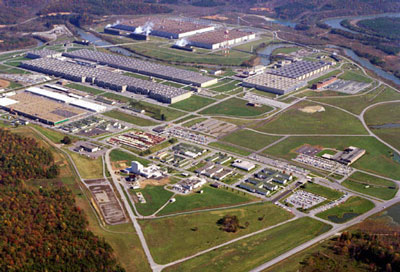


K-25
Complex 
Located west of the city of Oak Ridge in Tennessee, K-25 site began operations in 1945 as the Oak Ridge Gaseous Diffusion Plant. It was built as part of the Manhattan Project during World War II to supply enriched uranium for nuclear weapons production. Construction of K-25, the primary production building (also known as the "U"), started in 1943 and was fully operational by 1945. The K-25 facility, which was capable of enriching uranium to 95% U-235, was operable from 1945 - 1964. Additional buildings involved in the enrichment process at Oak Ridge included: K-27 (operable between 1945-1985 and capable of 20% enrichment); K-29 (operable between 1951-1985 and capable of 10% enrichment); and K-33 (operable between 1954-1985 and capable of 2% enrichment). K-31 and K-33 were used through 1985 for the production of enriched uranium that was supplied to nuclear reactors used to generate electric power. The K-25 site differs in two important ways from the other two gaseous diffusion plants (Paducah and Portsmouth). The K-25 site initially housed three production-scale enrichment processes (gaseous diffusion, gas centrifuge, and thermal diffusion). Eventually, gaseous diffusion was selected as the most favorable method of enrichment. The gas centrifuge program initiated in 1960 was cancelled in 1985 (building K-1200); and the thermal diffusion program was cancelled in 1946 (building S-50 and support building K-725). In addition, K-25 was the only site, which produced the “barriers”, used within the gaseous diffusion cascade system (building K-1037). Currently, plant management at K-25 is divided between Bechtel Jacobs Company, the primary contractor and a number of different subcontractors including: Westchem; Shaw; URL; OMI; Theta; Washington Group; Southern Logistics; Turnkey; Eagle Construction; and BNFL. |